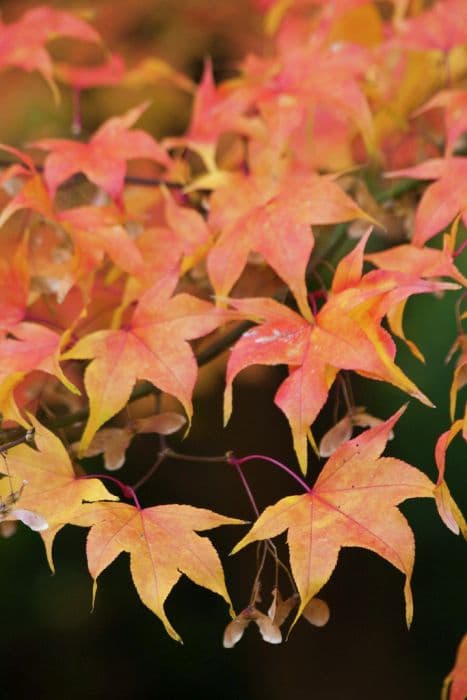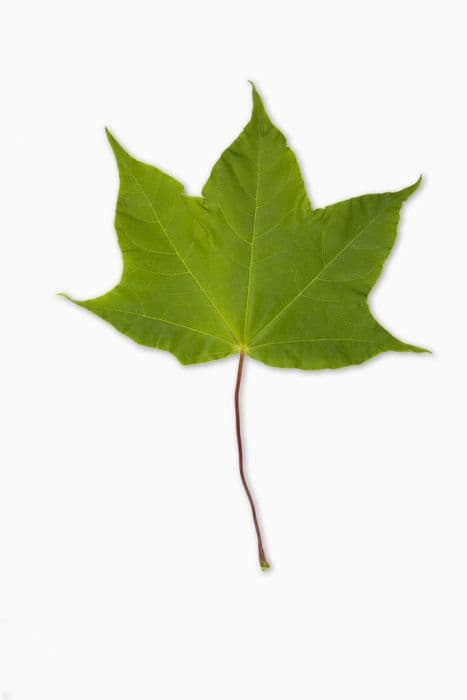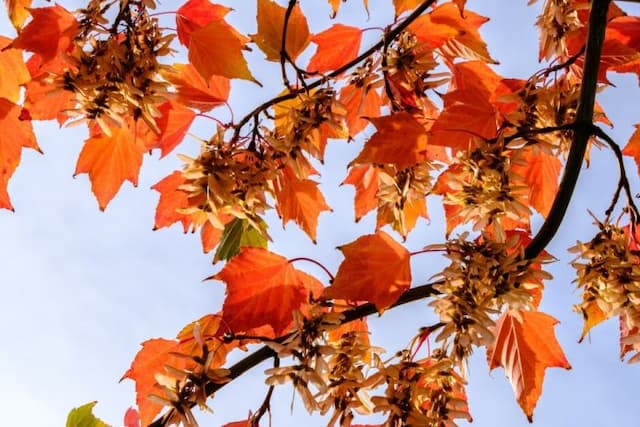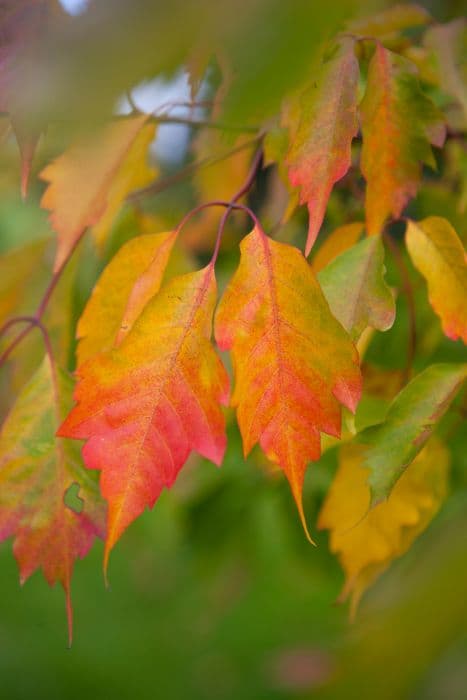Japanese Maple Acer palmatum 'Ichigyoji' (A)

ABOUT
The Japanese maple 'Ichigyoji' is a beautifully ornamental plant known for its distinctive foliage and seasonal color changes. Its leaves are shaped like elegant outstretched hands with multiple pointed lobes, reminiscent of the silhouette of a star. The foliage presents a rich, golden yellow hue in spring, transforming into a vibrant green as the season progresses. In the autumn, the leaves put on a stunning display, shifting into a mix of orange and crimson shades, making it a standout in any garden during this season. This Japanese maple variety has a graceful and airy branching structure, forming an attractive canopy that provides dappled shade below. The branches and twigs may display a subtle reddish-brown tone, which adds to the visual interest of the tree throughout the year. Its bark is usually smooth and accentuates the plant's delicate characteristics. The overall aesthetic of 'Ichigyoji' suits both traditional and contemporary garden designs, with its distinct leaf coloration and sculptural form making it a superb choice for a focal point in large landscapes or small, intimate garden spaces.
About this plant
 Names
NamesFamily
Sapindaceae
Synonyms
Japanese Maple, Smooth Japanese Maple
Common names
Acer palmatum 'Ichigyoji'.
 Toxicity
ToxicityTo humans
The Japanese Maple, commonly known as the plant in question, is not considered toxic to humans. There are no widespread reports of poisoning or toxic reactions from ingesting this plant. Therefore, no symptoms of poisoning are generally associated with the Japanese Maple for humans under normal circumstances.
To pets
The Japanese Maple is also not considered toxic to pets. It is not known to cause poisoning in animals such as dogs and cats if ingested. As with human exposure, there are no commonly recognized symptoms of poisoning linked to the ingestion of the Japanese Maple in pets. However, it is always best to prevent pets from eating plants as individual reactions can vary.
 Characteristics
CharacteristicsLife cycle
Perennials
Foliage type
Deciduous
Color of leaves
Green
Height
10-15 feet (3-4.5 meters)
Spread
10-15 feet (3-4.5 meters)
Plant type
Tree
Hardiness zones
5-9
Native area
Japan
Benefits
 General Benefits
General Benefits- Ornamental Appeal: Japanese maple 'Ichigyoji' is prized for its aesthetic qualities, adding visual interest to gardens with its unique foliage and graceful growth habit.
- Seasonal Color: It provides stunning seasonal color changes, with leaves that transform from green to golden-yellow to crimson in the fall.
- Shade Tolerance: This cultivar can grow in partial shade, expanding landscaping options for areas with limited direct sunlight.
- Compact Size: With a relatively small size, it is suitable for smaller gardens or spaces where larger trees cannot fit.
- Low Maintenance: Acer palmatum 'Ichigyoji' is known for being relatively low maintenance, requiring minimal pruning and care once established.
- Habitat Support: Like many trees, it can provide habitat and support for local wildlife, such as birds and beneficial insects.
- Versatility in Landscaping: This plant can be used in a variety of landscape designs including rock gardens, borders, and as a standalone specimen.
- Soil Adaptability: It is adaptable to a range of soil types, although it prefers well-draining, slightly acidic soil.
 Medical Properties
Medical PropertiesThis plant is not used for medical purposes.
 Air-purifying Qualities
Air-purifying QualitiesThis plant is not specifically known for air purifying qualities.
 Other Uses
Other Uses- Acer palmatum 'Ichigyoji' leaves can be used as a natural dye, producing hues that range from yellow to orange depending on the mordant used.
- Pressed Acer palmatum leaves can be incorporated into craft projects such as resin jewelry, encapsulating the beauty of the foliage in wearable art.
- Fallen leaves from the Acer palmatum can be used as mulch, adding nutrients back into the soil as they decompose and improving soil quality.
- Small branches and twigs pruned from Acer palmatum can be repurposed for bonsai construction, providing natural and aesthetically pleasing frameworks.
- The unique shape of Acer palmatum leaves can be used in floral arrangements, either fresh or dried, to add an exotic touch to bouquets and centerpieces.
- The wood from Acer palmatum, when pruned or thinned, can be used to create small woodworking projects such as pens, turnings, or decorative objects.
- In a culinary context, the leaves of Acer palmatum can be used to wrap food, adding an ornamental element to dishes.
- Dried and ground Acer palmatum leaves can be a component in potpourri mixes, contributing to the visual diversity and aroma.
- Photography enthusiasts can use the Acer palmatum as a subject or backdrop for nature photography, due to its vivid seasonal colors.
- Acer palmatum trees can serve as a living support for climbing plants or vines, creating a dynamic and symbiotic garden feature.
Interesting Facts
 Feng Shui
Feng ShuiThe Japanese Maple is not used in Feng Shui practice.
 Zodiac Sign Compitability
Zodiac Sign CompitabilityThe Japanese Maple is not used in astrology practice.
 Plant Symbolism
Plant Symbolism- Beauty and Elegance: The smooth lines and attractive foliage of the Japanese Maple represent grace and beauty.
- Peace and Tranquility: These trees are often used in Japanese gardens, which are designed for quiet reflection and meditation.
- Change and Transformation: The leaves of the Japanese Maple change color throughout the year, symbolizing the ever-changing nature of life.
- Balance and Harmony: The balanced shape and structure of the Japanese Maple's branches reflect the Japanese aesthetic of harmony and simplicity.
 Water
WaterJapanese Maple, known scientifically as Acer palmatum 'Ichigyoji,' requires even moisture and should be watered when the top inch of soil feels dry. In general, this might equate to watering once a week, but this can vary with local weather conditions and soil type. It's recommended to use about 2 gallons of water each time for a mature tree under typical garden conditions. During hot or windy weather, the tree may need additional water to prevent stress. It's important not to over-water as this can lead to root rot, so ensure good drainage and check the soil moisture regularly.
 Light
LightJapanese Maple thrives best in a location that offers part shade, especially protection from the harsh afternoon sun. Morning sun with afternoon shade or filtered light all day is ideal for Acer palmatum 'Ichigyoji'. Direct exposure to strong sunlight for extended periods can scorch the leaves, while deep shade can reduce the vibrancy of the foliage color.
 Temperature
TemperatureThe Japanese Maple prefers a temperate climate and can withstand winter temperatures down to about -10°F, the equivalent of USDA Zone 6. During the growing season, they appreciate a range between 50°F and 80°F. They are not ideally suited for extremely hot climates where summer temperatures frequently exceed 90°F for extended periods, as intense heat can stress the plant.
 Pruning
PruningPrune Japanese Maple primarily to remove dead or damaged wood and to thin out dense areas to allow light into the center of the plant. Pruning is best done in late winter or early spring before new growth starts. Major pruning is seldom required, and the natural shape is often most attractive, so only prune as needed. It's essential to avoid pruning in late fall or during the growing season when sap flow is high, as this can stress the tree and lead to excess sap loss.
 Cleaning
CleaningAs needed
 Soil
SoilJapanese Maple 'Ichigyoji' prefers a soil mix consisting of 1/3 organic matter like compost, 1/3 pumice or perlite for drainage, and 1/3 fine bark to provide aeration and moisture retention. The ideal soil pH should be slightly acidic, ranging from 5.5 to 6.5.
 Repotting
RepottingJapanese Maple 'Ichigyoji' should generally be repotted every two to three years to prevent it from becoming root-bound and to replenish nutrients in the soil. Spring is the best time for repotting, just before new growth begins.
 Humidity & Misting
Humidity & MistingJapanese Maple 'Ichigyoji' prefers moderate to high humidity levels; however, it is quite adaptable and can tolerate the average outdoor humidity in most temperate climates.
 Suitable locations
Suitable locationsIndoor
Ensure bright, indirect light and good air circulation.
Outdoor
Plant in partial shade, shelter from strong winds.
Hardiness zone
5-8 USDA
 Life cycle
Life cycleThe Japanese Maple 'Ichigyoji' begins its life cycle with seed germination, which usually occurs in spring following a period of stratification to break dormancy. The seeds develop into seedlings, which gradually establish a root system and sprout their first leaves. As the plant matures, it enters a vegetative growth phase, producing characteristic palmate leaves and a woody stem structure, developing into a small deciduous tree or shrub. The Japanese Maple 'Ichigyoji' reaches reproductive maturity after several years, producing small red or purple flowers in spring, which after pollination, turn into winged samaras, or seed pods, that disperse in the wind. The tree continues to grow and can live for several decades, going through annual cycles of foliage growth in the spring, leaf color transformation to vibrant oranges or reds in the fall, and leaf drop in the winter. The plant eventually declines with age, leading to reduced vigor, potential disease susceptibility, and finally death, at which point the seeds complete the cycle by giving rise to new plants.
 Propogation
PropogationPropogation time
Early Spring
For the Japanese maple 'Ichigyoji', the most popular method of propagation is by grafting, commonly performed in late winter or early spring before the new growth starts. Grafting involves attaching a scion of the 'Ichigyoji' to the rootstock of a compatible Acer species, which then fuses together to create a new plant. The scion is a cutting, typically 4 to 6 inches (10 to 15 centimeters) long, collected from a healthy 'Ichigyoji' maple. It is important that the cutting is made at a diagonal angle and includes at least a couple of buds. The rootstock should be prepared by making a similar angled cut where the graft will occur. The cut surfaces are then joined together, making sure the cambium layers (the growing tissues just under the bark) of both the scion and the rootstock match up. The joint is secured with grafting tape or a similar binding material and the wound is typically coated with a grafting sealant to prevent dehydration and infection while the graft heals.









